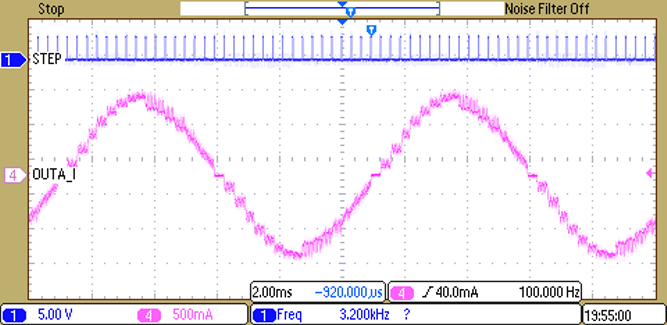SLVS865J September 2008 – April 2017 DRV8811
PRODUCTION DATA.
- 1 Features
- 2 Applications
- 3 Description
- 4 Revision History
- 5 Pin Configuration and Functions
- 6 Specifications
- 7 Detailed Description
- 8 Application and Implementation
- 9 Power Supply Recommendations
- 10Layout
- 11Device and Documentation Support
- 12Mechanical, Packaging, and Orderable Information
8 Application and Implementation
NOTE
Information in the following application section is not part of the TI component specification, and TI does not warrant its accuracy or completeness. TI’s customers are responsible for determining suitability of components for their purposes. Customers should validate and test their design implementation to confirm system functionality.
8.1 Application Information
The DRV8811 device is used for bipolar stepper-motor control. The microstepping motor driver provides precise regulation of the coil current and ensures a smooth rotation from the stepper motor.
8.2 Typical Application
Figure 9 shows a common system application of the DRV8811 device.
 Figure 9. Typical Application Schematic
Figure 9. Typical Application Schematic
8.2.1 Design Requirements
Table 3. Design Parameters
| DESIGN PARAMETER | REFERENCE | EXAMPLE VALUE |
|---|---|---|
| Supply voltage | VM | 24 V |
| Motor winding resistance | RL | 4 Ω |
| Motor winding inductance | IL | 3.7 mH |
| Motor full-step angle | θstep | 1.8° |
| Target microstepping level | nm | 8 µsteps per step |
| Target motor speed | V | 120 rpm |
| Target full-scale current | IFS | 1.25 A |
8.2.2 Detailed Design Procedure
8.2.2.1 Stepper Motor Speed
The first step in configuring the DRV8811 device requires the desired motor speed and microstepping level. If the target application requires a constant speed, then a square wave with frequency ƒstep must be applied to the STEP pin.
If the target motor start-up speed is too high, the motor does not spin. Make sure that the motor can support the target speed, or implement an acceleration profile to bring the motor up to speed.
For a desired motor speed (v), microstepping level (nm), and motor full step angle (θstep),


θstep can be found in the stepper motor data sheet or written on the motor itself.
For the DRV8811 device, the microstepping level is set by the USMx pins. Higher microstepping means a smother motor motion and less audible noise, but increases switching losses and require a higher fstep to achieve the same motor speed.
8.2.2.2 Current Regulation
In a stepper motor, the set full-scale current (IFS) is the maximum current driven through either winding. This quantity depends on the VVREF analog voltage and the sense resistor value (RSENSE). During stepping, IFS defines the current chopping threshold (ITRIP) for the maximum current step. The gain of DRV8811 device is set for 8 V/V.

To achieve IFS = 1.25 A with RSENSE of 0.1 Ω, VVREF should be 1 V.
8.2.2.3 Decay Modes
The DRV8811 device supports three different decay modes: slow decay, fast decay, and mixed decay. The current through the motor windings is regulated using a fixed off-time scheme.
This means that the current increases until it reaches the current chopping threshold (ITRIP), after which it enters the configured decay mode for a fixed period of time. The cycle then repeats after the decay period expires.
The blanking time tBLANK defines the minimum drive time for the current chopping. ITRIP is ignored during tBLANK, so the winding current may overshoot the trip level.
8.2.3 Application Curves


